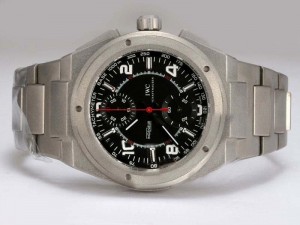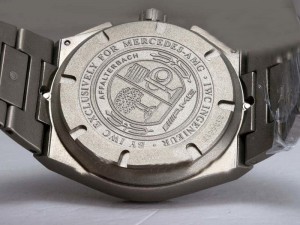IWC has introduced a new Spitfire squadron in its Pilot’s Watches collection, which debuts in 2019. For the first time, the Pilot’s Watch Automatic Spitfire houses in its case a self-winding movement from the new 32000 Series manufacture movement. 

“Have I seen this watch somewhere before?” That’s what you might think when you see the classic Pilot’s Watch Automatic Spitfire for the first time. And you wouldn’t be wrong, because its design was inspired by the legendary Mark 11 from 1948.
In the late 1940s, IWC was invited by the British government to develop a special watch for Royal Air Force pilots. It was equipped with IWC’s equally popular hand-wound caliber 89, whose soft-iron inner case protected it from the adverse effects of magnetic fields. The boldly designed dial is legible during the day and at night. The Mark XII with automatic movement and date display followed, but connoisseurs had to wait until 1994 for its final appearance.
Flanked by two dots in a triangle, this was borrowed from a historical pilot’s replica watches. It ensured – and continues to ensure – better positioning of the watch hands in a dark cockpit. The beige coating of this triangle is a nostalgic accent on the dial. The same beige hue – and the same nostalgic sentiment – recurs on the two main hands as well as on the three scales used to display the quarter-hour, half-hour, and three-quarter-hour. On the other hand, the bright green luminescent coating on the hour and minute hands and on the four indicators is characteristic of replica IWC Pilot’s Watches, dating back at least to Mark 11.
IWC’s self-winding manufacture caliber 32110 is the newest addition to this functional Pilot’s Watch. The 32000 series was designed as a basic movement family with a focus on robustness and reliability. Like the previous basic chronograph movement, the 69000, this new piece is designed to replace the externally sourced movements from ETA and Sellita. As the price of this fake watch suggests, the new in-house movement can be added at almost no additional cost.
The long-running autonomy is made possible by advanced movement technology. Among other new features here, IWC’s movement uses silicon components for the first time. The escapement wheel and anchor are made of this wear-resistant, non-magnetic material, but unfortunately, the hairspring is not, so a soft iron inner casing is still needed to provide additional protection against magnetic fields. A newly developed lubricant extends the life of the components.